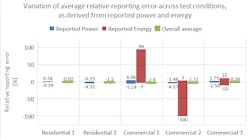The solid-state lighting (SSL) industry has come a long way in establishing standards for testing and rating both LED components and LED-based systems, although as the US Department of Energy (DOE) points out, there is still no definitive way to rate system life expectations. There are improved ways to test for and project lumen maintenance, but other failure mechanisms including driver life and system-level color maintenance remain hard to quantify.
The new DOE fact sheet on the topic, entitled " Lifetime and reliability," attempts to define all of the standards and projection methods that exist, and where the shortcomings exist in fully defining the characteristics of a SSL product at the system level. The main problems include the fact that existing methodology is primarily focused on lumen depreciation as the only failure mechanism, and there is no standardized methodology to rate elements that go into an SSL system beyond the light source.
The IES LM-80 standard provides definitive test methodology for white LED components. Most people discuss LM-80 relative to lumen depreciation and specification of time to L70 or 70% of initial flux output measured in thousands of hours. But LM-80 also defines component color maintenance and color shift. The IES TM-21 standard adds a way to project life beyond the 6000 hours of testing required by LM-80.
Today there is no way to test or project color maintenance at the system level. The DOE said that color shift has been less of an issue because it's more of an inconvenience as opposed to a safety issue whereas a drop in light output could be a safety issue. Still lighting designers and specifiers would consider an unacceptable color shift as product failure.
Help is coming. The IES LM-84 standard will define methods for measuring both lumens and color maintenance at the lamp or luminaire level. Moreover the TM-28 will prescribe methods to project lamp life based on LM-84 data. Later the IES may add projection methods for luminaires to TM-28.
The fact sheet does not offer a full solution for measuring and projecting lifetime or reliability. The report states that with maturing LED and SSL technology, the issue may subside to some point but also noted "the products will continue to fail both catastrophically and parametrically, through various mechanisms."
The DOE also mentioned the possibility that the industry may be better off with products rated for shorter lifetime such as 10–15 years rather than say 30 years, because lighting is often remodeled on a shorter cycle. We covered similar ground in a recent editorial. The DOE did add that shorter life impacts sustainability because more waste material is generated.
One thing that the fact sheet does not address is how lifetime and reliability are impacted in products that use a mix of colored LEDs, or a technology such as remote phosphor that relies on royal blue LEDs, often referred to as blue pumps. The existing standards such as LM-80 only define test methods for phosphor-converted white LEDs. But other system architectures are becoming very popular in some applications.



![An installer uses a cell phone to configure a connected lighting system in a Next Generation Lighting Systems (NGLS) living lab. [Photo credit: Image courtesy of Pacific Northwest National Laboratory (PNNL) and NGLS.] An installer uses a cell phone to configure a connected lighting system in a Next Generation Lighting Systems (NGLS) living lab. [Photo credit: Image courtesy of Pacific Northwest National Laboratory (PNNL) and NGLS.]](https://img.ledsmagazine.com/files/base/ebm/leds/image/2020/06/NGLS_Photo_2.5ed693de53fa2.png?auto=format,compress&fit=crop&q=45&h=139&height=139&w=250&width=250)


